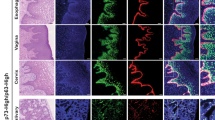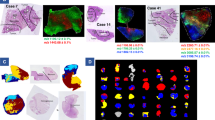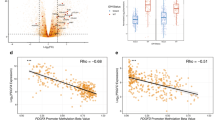Abstract
The tumor suppressor p53 has been found to be the most commonly mutated gene in human cancers; however, the frequency of p53 mutations varies from 10 to 70% across different cancer types. This variability can partly be explained by inactivating mechanisms aside from direct genomic polymorphisms. The p53 gene encodes 12 isoforms, some of which can modulate full-length p53 activity in cancer. In this study, we characterized p53 isoform expression patterns in glioblastoma, gliosis, non-tumor brain and neural progenitor cells by SDS–PAGE, immunoblot, mass spectrometry and reverse transcription–PCR. We found that the most consistently expressed isoform in glioblastoma, Δ40p53, was uniquely expressed in regenerative processes, such as those involving neural progenitor cells and gliosis compared with tumor samples. Isoform profiling of glioblastoma tissues revealed the presence of both Δ40p53 and full-length p53, neither of which were detected in non-tumor cerebral cortex. Upon xenograft propagation of tumors, p53 levels increased. The variability of overall p53 expression and relative levels of isoforms suggest fluctuations in subpopulations of cells with greater or lesser capacity for proliferation, which can change as the tumor evolves under different growth conditions.
This is a preview of subscription content, access via your institution
Access options
Subscribe to this journal
Receive 50 print issues and online access
$259.00 per year
only $5.18 per issue
Buy this article
- Purchase on Springer Link
- Instant access to full article PDF
Prices may be subject to local taxes which are calculated during checkout





Similar content being viewed by others
References
Machado-Silva A, Perrier S, Bourdon JC . p53 family members in cancer diagnosis and treatment. Semin Cancer Biol 2010; 20: 57–62.
Robles AI, Harris CC . Clinical outcomes and correlates of TP53 mutations and cancer. Cold Spring Harb Perspect Biol 2010; 2: a001016.
Hollstein M, Sidransky D, Vogelstein B, Harris CC . p53 mutations in human cancers. Science 1991; 253: 49–53.
Levine AJ, Momand J, Finlay CA . The p53 tumour suppressor gene. Nature 1991; 351: 453–456.
Petitjean A, Mathe E, Kato S, Ishioka C, Tavtigian SV, Hainaut P et al. Impact of mutant p53 functional properties on TP53 mutation patterns and tumor phenotype: lessons from recent developments in the IARC TP53 database. Hum Mutat 2007; 28: 622–629.
Cancer Genome Atlas Research Network. Comprehensive genomic characterization defines human glioblastoma genes and core pathways. Nature 2008; 455: 1061–1068.
Butler T, Gribben JG . Biologic and clinical significance of molecular profiling in chronic lymphocytic leukemia. Blood Rev 2010; 24: 135–141.
Li W, Sanki A, Karim RZ, Thompson JF, Soon Lee C, Zhuang L et al. The role of cell cycle regulatory proteins in the pathogenesis of melanoma. Pathology 2006; 38: 287–301.
Soussi T . The TP53 web site. Paris 2010 [updated July 2010; cited 2011 September 10]; Available from http://p53.free.fr/Database/p53_cancer_db.html.
Van Meir EG, Kikuchi T, Tada M, Li H, Diserens AC, Wojcik BE et al. Analysis of the p53 gene and its expression in human glioblastoma cells. Cancer Res 1994; 54: 649–652.
Anensen N, Oyan AM, Bourdon JC, Kalland KH, Bruserud O, Gjertsen BT . A distinct p53 protein isoform signature reflects the onset of induction chemotherapy for acute myeloid leukemia. Clin Cancer Res 2006; 12: 3985–3992.
Avery-Kiejda KA, Zhang XD, Adams LJ, Scott RJ, Vojtesek B, Lane DP et al. Small molecular weight variants of p53 are expressed in human melanoma cells and are induced by the DNA-damaging agent cisplatin. Clin Cancer Res 2008; 14: 1659–1668.
Boldrup L, Bourdon JC, Coates PJ, Sjostrom B, Nylander K . Expression of p53 isoforms in squamous cell carcinoma of the head and neck. Eur J Cancer 2007; 43: 617–623.
Bourdon JC, Fernandes K, Murray-Zmijewski F, Liu G, Diot A, Xirodimas DP et al. p53 isoforms can regulate p53 transcriptional activity. Genes Dev 2005; 19: 2122–2137.
Marcel V, Perrier S, Aoubala M, Ageorges S, Groves MJ, Diot A et al. Delta160p53 is a novel N-terminal p53 isoform encoded by Delta133p53 transcript. FEBS Lett 2010; 584: 4463–4468.
Ungewitter E, Scrable H . Delta40p53 controls the switch from pluripotency to differentiation by regulating IGF signaling in ESCs. Genes Dev 2010; 24: 2408–2419.
Ghosh A, Stewart D, Matlashewski G . Regulation of human p53 activity and cell localization by alternative splicing. Mol Cell Biol 2004; 24: 7987–7997.
Courtois S, Verhaegh G, North S, Luciani MG, Lassus P, Hibner U et al. DeltaN-p53, a natural isoform of p53 lacking the first transactivation domain, counteracts growth suppression by wild-type p53. Oncogene 2002; 21: 6722–6728.
Philipova T, Baryawno N, Hartmann W, Pietsch T, Druid H, Johnsen JI et al. Differential forms of p53 in medulloblastoma primary tumors, cell lines and xenografts. Int J Oncol 2011; 38: 843–849.
Khoury MP, Bourdon JC . The isoforms of the p53 protein. Cold Spring Harb Perspect Biol 2010; 2: a000927.
Mills AA . p53: link to the past, bridge to the future. Genes Dev 2005; 19: 2091–2099.
Rovinski B, Munroe D, Peacock J, Mowat M, Bernstein A, Benchimol S . Deletion of 5′-coding sequences of the cellular p53 gene in mouse erythroleukemia: a novel mechanism of oncogene regulation. Mol Cell Biol 1987; 7: 847–853.
Yin Y, Stephen CW, Luciani MG, Fahraeus R . p53 Stability and activity is regulated by Mdm2-mediated induction of alternative p53 translation products. Nat Cell Biol 2002; 4: 462–467.
Ray PS, Grover R, Das S . Two internal ribosome entry sites mediate the translation of p53 isoforms. EMBO Rep 2006; 7: 404–410.
Grover R, Candeias MM, Fahraeus R, Das S . p53 and little brother p53/47: linking IRES activities with protein functions. Oncogene 2009; 28: 2766–2772.
Matlashewski G, Pim D, Banks L, Crawford L . Alternative splicing of human p53 transcripts. Oncogene Res 1987; 1: 77–85.
Candeias MM, Powell DJ, Roubalova E, Apcher S, Bourougaa K, Vojtesek B et al. Expression of p53 and p53/47 are controlled by alternative mechanisms of messenger RNA translation initiation. Oncogene 2006; 25: 6936–6947.
Boldrup L, Bourdon JC, Coates PJ, Sjostrom B, Nylander K . Expression of p53 isoforms in squamous cell carcinoma of the head and neck. Eur J Cancer 2007; 43: 617–623.
Bunz F, Dutriaux A, Lengauer C, Waldman T, Zhou S, Brown JP et al. Requirement for p53 and p21 to sustain G2 arrest after DNA damage. Science 1998; 282: 1497–1501.
Kleihues P, Burger PC, Scheithauer BW . The new WHO classification of brain tumours. Brain Pathol 1993; 3: 255–268.
Singh SK, Hawkins C, Clarke ID, Squire JA, Bayani J, Hide T et al. Identification of human brain tumour initiating cells. Nature 2004; 432: 396–401.
Sanai N, Alvarez-Buylla A, Berger MS . Neural stem cells and the origin of gliomas. N Engl J Med 2005; 353: 811–822.
Globus J, Kulenbeck H . Tumors of the striatothalamic and related regions: their probable source of origin and more common forms. Arch Pathol 1942; 24: 674–734.
Globus J, Kuhlenbeck H . The subependymal cell plate (matrix) and its relationship to brain tumors of the ependymal type. J Neuropathol Exp Neurol 1944; 3: 1–35.
Shoshan Y, Nishiyama A, Chang A, Mork S, Barnett GH, Cowell JK et al. Expression of oligodendrocyte progenitor cell antigens by gliomas: implications for the histogenesis of brain tumors. Proc Natl Acad Sci USA 1999; 96: 10361–10366.
Doetsch F, Petreanu L, Caille I, Garcia-Verdugo JM, Alvarez-Buylla A . EGF converts transit-amplifying neurogenic precursors in the adult brain into multipotent stem cells. Neuron 2002; 36: 1021–1034.
Palmer TD, Willhoite AR, Gage FH . Vascular niche for adult hippocampal neurogenesis. J Comp Neurol 2000; 425: 479–494.
Ben-Porath I, Thomson MW, Carey VJ, Ge R, Bell GW, Regev A et al. An embryonic stem cell-like gene expression signature in poorly differentiated aggressive human tumors. Nat Genet 2008; 40: 499–507.
Leonard BW, Mastroeni D, Grover A, Liu Q, Yang K, Gao M et al. Subventricular zone neural progenitors from rapid brain autopsies of elderly subjects with and without neurodegenerative disease. J Comp Neurol 2009; 515: 269–294.
Medrano S, Burns-Cusato M, Atienza MB, Rahimi D, Scrable H . Regenerative capacity of neural precursors in the adult mammalian brain is under the control of p53. Neurobiol Aging 2009; 30: 483–497.
Lendahl U, Zimmerman LB, McKay RD . CNS stem cells express a new class of intermediate filament protein. Cell 1990; 60: 585–595.
Doetsch F, Caille I, Lim DA, Garcia-Verdugo JM, Alvarez-Buylla A . Subventricular zone astrocytes are neural stem cells in the adult mammalian brain. Cell 1999; 97: 703–716.
Laywell ED, Kukekov VG, Steindler DA . Multipotent neurospheres can be derived from forebrain subependymal zone and spinal cord of adult mice after protracted postmortem intervals. Exp Neurol 1999; 156: 430–433.
Imura T, Kornblum HI, Sofroniew MV . The predominant neural stem cell isolated from postnatal and adult forebrain but not early embryonic forebrain expresses GFAP. J Neurosci 2003; 23: 2824–2832.
Imura T, Nakano I, Kornblum HI, Sofroniew MV . Phenotypic and functional heterogeneity of GFAP-expressing cells in vitro: differential expression of LeX/CD15 by GFAP-expressing multipotent neural stem cells and non-neurogenic astrocytes. Glia 2006; 53: 277–293.
Garcia AD, Doan NB, Imura T, Bush TG, Sofroniew MV . GFAP-expressing progenitors are the principal source of constitutive neurogenesis in adult mouse forebrain. Nat Neurosci 2004; 7: 1233–1241.
Doetsch F, Garcia-Verdugo JM, Alvarez-Buylla A . Cellular composition and three-dimensional organization of the subventricular germinal zone in the adult mammalian brain. J Neurosci 1997; 17: 5046–5061.
Reynolds BA, Tetzlaff W, Weiss S . A multipotent EGF-responsive striatal embryonic progenitor cell produces neurons and astrocytes. J Neurosci 1992; 12: 4565–4574.
Reynolds BA, Weiss S . Generation of neurons and astrocytes from isolated cells of the adult mammalian central nervous system. Science 1992; 255: 1707–1710.
Reynolds BA, Weiss S . Clonal and population analyses demonstrate that an EGF-responsive mammalian embryonic CNS precursor is a stem cell. Dev Biol 1996; 175: 1–13.
Gard AL, Pfeiffer SE . Two proliferative stages of the oligodendrocyte lineage (A2B5+O4− and O4+GalC−) under different mitogenic control. Neuron 1990; 5: 615–625.
Buffo A, Rite I, Tripathi P, Lepier A, Colak D, Horn AP et al. Origin and progeny of reactive gliosis: a source of multipotent cells in the injured brain. Proc Natl Acad Sci USA 2008; 105: 3581–3586.
Lang B, Liu HL, Liu R, Feng GD, Jiao XY, Ju G . Astrocytes in injured adult rat spinal cord may acquire the potential of neural stem cells. Neuroscience 2004; 128: 775–783.
Petitjean A, Achatz MI, Borresen-Dale AL, Hainaut P, Olivier M . TP53 mutations in human cancers: functional selection and impact on cancer prognosis and outcomes. Oncogene 2007; 26: 2157–2165.
Oren M, Rotter V . Mutant p53 gain-of-function in cancer. Cold Spring Harb Perspect Biol 2010; 2: a001107.
Goh AM, Coffill CR, Lane DP . The role of mutant p53 in human cancer. J Pathol 2011; 223: 116–126.
Sasaki T, Maier B, Bartke A, Scrable H . Progressive loss of SIRT1 with cell cycle withdrawal. Aging Cell 2006; 5: 413–422.
Carlson BL, Pokorny JL, Schroeder MA, Sarkaria JN . Establishment, maintenance and in vitro and in vivo applications of primary human glioblastoma multiforme (GBM) xenograft models for translational biology studies and drug discovery. Curr Protoc Pharmacol 2011; 52: 1–14.
Murray-Zmijewski F, Lane DP, Bourdon JC . p53/p63/p73 isoforms: an orchestra of isoforms to harmonise cell differentiation and response to stress. Cell Death Differ 2006; 13: 962–972.
Ishii N, Maier D, Merlo A, Tada M, Sawamura Y, Diserens AC et al. Frequent co-alterations of TP53, p16/CDKN2A, p14ARF, PTEN tumor suppressor genes in human glioma cell lines. Brain Pathol 1999; 9: 469–479.
Gritti A, Galli R, Vescovi A . Protocols for Neural Cell Culture 3rd edn. Fedoroff S, Richardson A, (eds). Humana Press, Inc, Totowa, 2001.
Acknowledgements
We would like to thank our Mayo Clinic colleagues for their contributions, in particular, Dr Robert Jenkins for seminal discussions on the etiology of GBM and xenograft biology; Alissa Caron for preparing GBM patient tumor specimens; Dr John Black for CTX samples; Guido Gonzalez for obtaining LNZ308 cells; and Benjamin Madden and the Mayo Clinic Protein Chemistry and Proteomics Shared Resource core for mass spectrometry analysis. We are grateful to past and current members of the Scrable lab for their enduring enthusiasm and abilities, in particular Dr Erica Ungewitter for her invaluable help with p53 antibodies and the work she did as a graduate student that laid the foundation for subsequent studies on p53 in ESCs, and Dr Silvia Medrano, for passing on her expertise with mouse NSC culture and the role of p53 in adult stem cells. This work was supported by PHS award R01AG026094 and a Senior Scholar in Aging award from the Ellison Medical Research Foundation to HS Additional support came from an NCI Cancer Center support grant to the Mayo Clinic Cancer Center, the Robert and Arlene Kogod Center on Aging at Mayo Clinic, the Mayo Brain Tumors SPORE, and the Mayo Clinic Medical Scientist Training Program (RT).
Author information
Authors and Affiliations
Corresponding author
Ethics declarations
Competing interests
The authors declare no conflict of interest.
Additional information
Supplementary Information accompanies the paper on the Oncogene website
Supplementary information
Rights and permissions
About this article
Cite this article
Takahashi, R., Giannini, C., Sarkaria, J. et al. p53 isoform profiling in glioblastoma and injured brain. Oncogene 32, 3165–3174 (2013). https://doi.org/10.1038/onc.2012.322
Received:
Revised:
Accepted:
Published:
Issue Date:
DOI: https://doi.org/10.1038/onc.2012.322
Keywords
This article is cited by
-
Unveiling the etiological impact of GST-M1, GST-T1, and P53 genotypic variations on brain carcinogenesis
Molecular Biology Reports (2024)
-
It is not all about the alpha: elevated expression of p53β variants is associated with lower probability of survival in a retrospective melanoma cohort
Cancer Cell International (2023)
-
The p53 endoplasmic reticulum stress-response pathway evolved in humans but not in mice via PERK-regulated p53 mRNA structures
Cell Death & Differentiation (2023)
-
p53 isoform expression promotes a stemness phenotype and inhibits doxorubicin sensitivity in breast cancer
Cell Death & Disease (2023)
-
Tracing the origins of glioblastoma by investigating the role of gliogenic and related neurogenic genes/signaling pathways in GBM development: a systematic review
World Journal of Surgical Oncology (2022)



